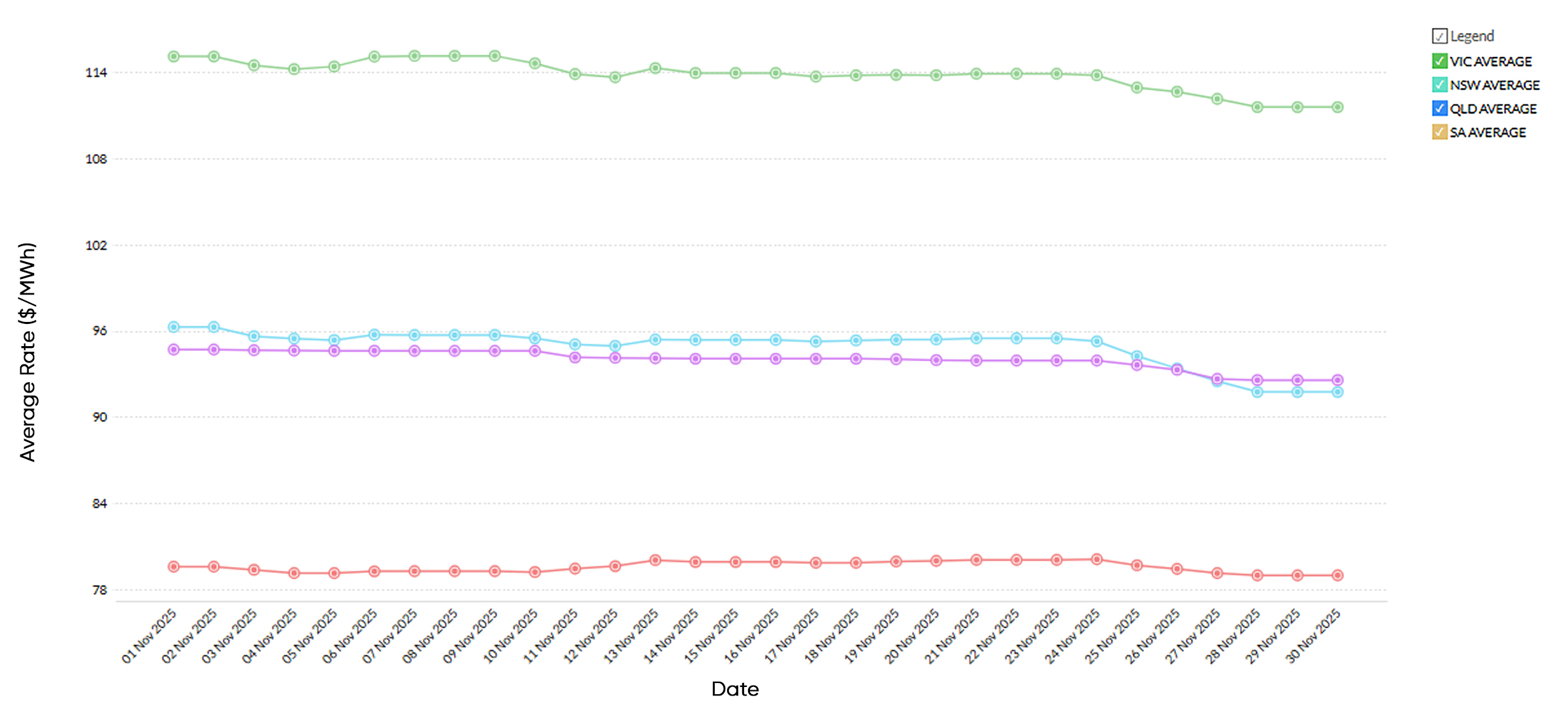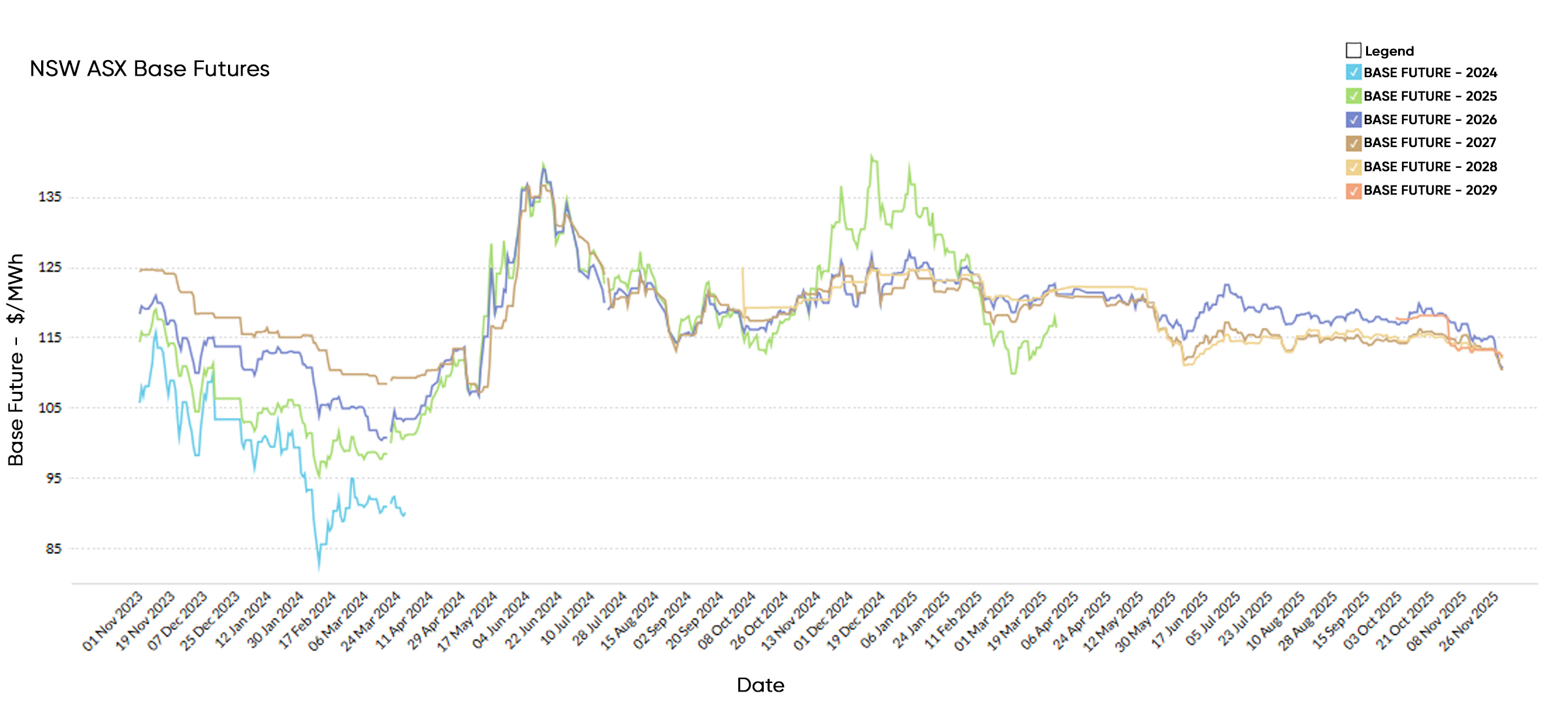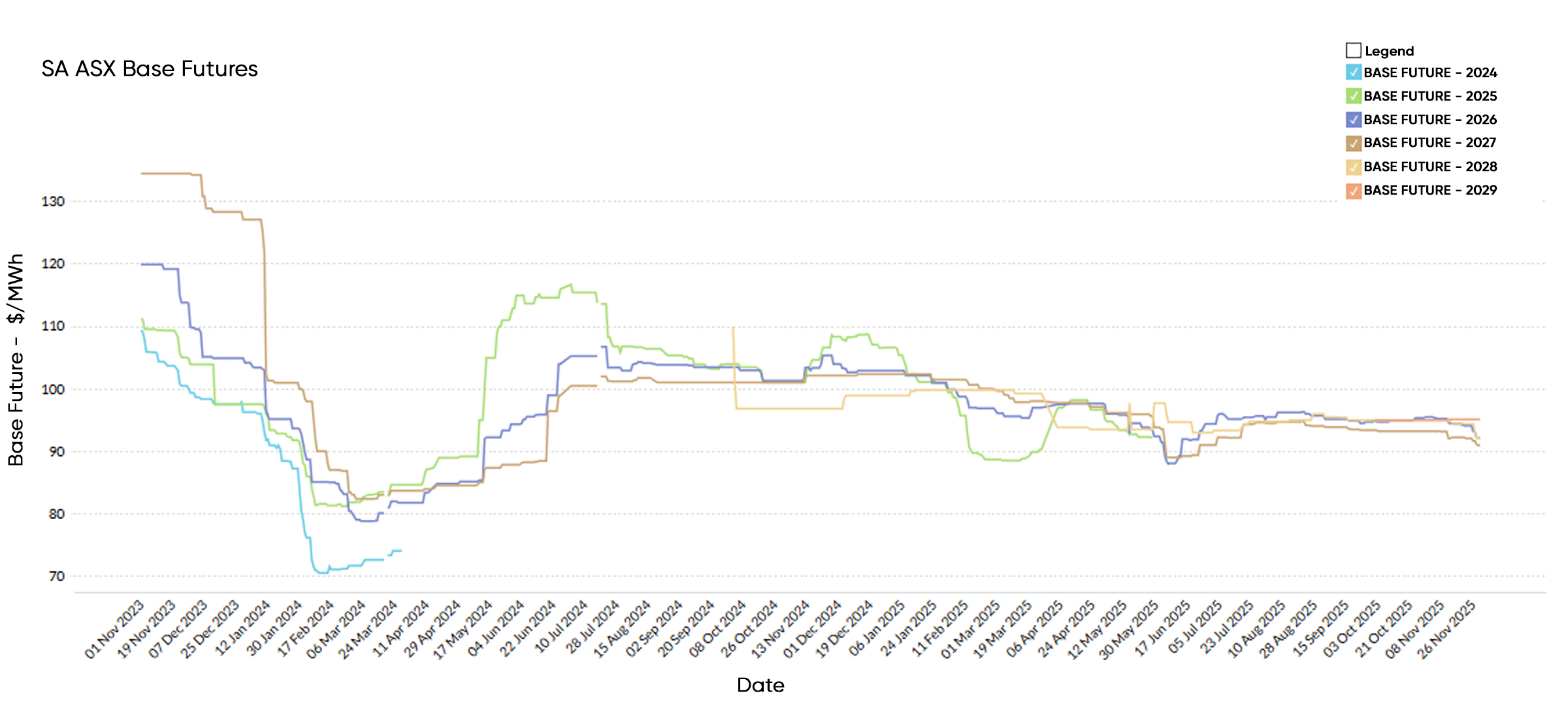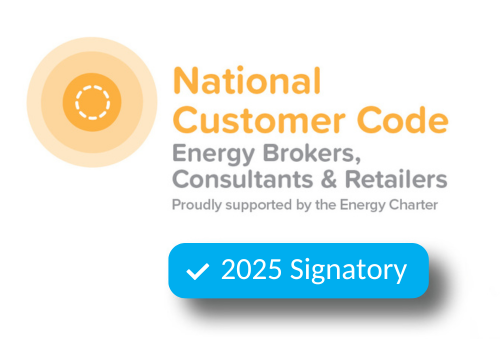
As spring shifted into early summer, the National Electricity Market (NEM) delivered another month of calm headline pricing – but November also underlined several deeper pressures that matter for business energy budgets.
Average NEM spot prices fell to $48.98/MWh, down from $51.00/MWh in October and dramatically lower than November 2024’s $123.60/MWh. Mild weather, strong renewable output and increased battery participation kept volatility subdued across most states.
State outcomes:
- New South Wales held steady at $76.93/MWh, albeit with a burst of volatility late in the month.
- Queensland rose to $63.05/MWh, ahead of a storm season that often disrupts both supply and demand [read more].
- Victoria fell to $31.92/MWh, reflecting one of the strongest renewable months on record.
- South Australia dropped to $32.48/MWh, driven overwhelmingly by wind and rooftop solar.
- Tasmania eased to $40.51/MWh, supported by hydro inflows.
Futures also softened. The average FY 2027 contract across NSW, VIC, QLD and SA fell from $96.90/MWh to $93.72/MWh, signalling that traders are pricing less near-term risk as spot markets remain very soft.
For businesses, this is important: when futures fall, the cost of forward contracts tends to follow, creating an opportunity to secure better rates for 2026–27 than were available a few months ago.
At the same time, November showed clearly that low prices do not automatically mean a low-risk system.
Futures Soften, Spot Stays Low – But the System Is Getting More Complex
Forward prices eased for a second straight month, driven by:
- very low spot prices
- mild weather and subdued demand
- fewer unplanned outages
- strong rooftop and grid-scale solar
- increased battery discharge into evening peaks
- weaker sentiment in the ASX energy sector
- structural uncertainty after changes to ASX energy futures contract formats.
These forces helped push Q1 2026 and FY 2027 contracts lower. But the month also highlighted several warning signs that traders – and business buyers – are watching closely.
- Industrial risk: Industrial risk rose back into focus when Tomago Aluminium reiterated it cannot remain viable “without affordable renewable energy at scale,” raising concerns around future large-load stability [analysis here].
- Operating conditions at the Waratah Super Battery also drew scrutiny, with extended outages reinforcing the risks of depending on firming assets not yet delivering consistent performance [details].
- Firming risk: Operational issues at the Waratah Super Battery and extended outages reinforced the risk of depending on firming assets that are not yet delivering consistent performance.
- Tariff and retail risk (QLD): For Queensland customers, upcoming Ergon Tariff 2025 reforms remain a key forward cost driver [overview], while tariff caps and “free solar” offers continue reshaping daytime demand and retail product economics [explainer].
Business takeaway:
Futures are cheaper than they were – but they are cheaper because the month was kind to the system, not because the transition risks have disappeared.
Operational Stress Events: Calm… Until It Isn’t
For most of November, volatility was negligible.
Then, between 25–27 November, NSW experienced violent price swings – from near floor prices to the Market Price Cap within minutes. Drivers included:
- local network constraints
- sudden demand ramps
- dispatch and data irregularities
- batteries being forced to charge in high-price periods due to stability constraints rather than commercial logic.
Across the NEM, AEMO also reported several frequency disturbances and system-strength “wobbles”, some linked to data glitches rather than plant failures. Outages such as Yallourn Unit 2’s delay into January put mild upward pressure on Victorian futures even as spot remained low.
On the regulatory side:
- AEMO’s Voluntary Scheduled Resources Guidelines clarified how batteries and flexible loads interact with central dispatch.
- The AEMC’s Draft 2026 Reliability Standard Review set out early thinking on future reliability settings – something traders watch closely.
- Proposed changes to the 2026–27 Default Market Offer (DMO) will have flow-through effects on retail pricing and margins [summary].
Business takeaway:
Most of the time, the system looks calm. But when something goes wrong – a constraint, a glitch, an outage – prices can still move violently, especially in NSW. Your business is shielded from these swings only if your contract is structured well.
Why Low Prices Haven’t Automatically Lowered Your Bills
Many business owners are asking the same question:
“If the market is so low, why are my bills still high?”
The short answer: you’re still paying the price you locked in, and the structural risks that drove that price haven’t gone away.
Key points:
- You’re on yesterday’s contract.
Most current contracts were signed when futures were higher (2022–23). Today’s lower futures affect your next contract, not your current one. The current softer futures market only influences your next renewal – making it important to work with a consultant like Leading Edge Energy who can guide you through the timing of market shifts and major events.
- Renewable oversupply helps in the middle of the day – not always when you use power.
Daytime prices are smashed by solar, but most businesses use the bulk of their energy in the early morning and late afternoon/evening. Those hours still rely heavily on coal, gas and batteries – and stay relatively more expensive.
- Transmission delays mean not all the new renewable energy can get to where demand is. That keeps evening and peak prices higher than they would be in a fully built-out grid.
- Battery and system constraints mean technology can’t always respond purely to price. When constraints force batteries to charge at high prices or restrict flows, some of the benefit of cheap daytime power is lost.
- Gas and LNG exposure keep peak prices elevated in states where gas is still the marginal fuel.
The AEMC’s latest outlook reinforces this picture: it expects household electricity prices to fall by around 5% by 2030, but to rise by up to 13% after 2030 if renewable and transmission investment falls behind. Wholesale cost expectations are now around 70% higher on average than the AEMC projected last year – a direct sign that delays translate into higher prices later.
Business takeaway:
Today’s low prices reflect good conditions and heavy management, not a permanently cheap system. Your bills only fall when you use those conditions to negotiate a better forward rate.
The Emerging Picture
November showed a NEM that is:
- Calm on the surface, with low spot prices and modest volatility.
- Heavily managed underneath, with batteries, directions, and constraints doing more work than ever.
- Still pricing long-term risk, even as near-term futures soften.
Low prices persisted all month – until a few hours of NSW volatility reminded everyone how quickly things can move when stress hits. Traders cut near-term risk premiums but kept longer-dated prices relatively elevated, because:
- coal exits
- firming and storage gaps
- transmission delays
- large-load fragility
all remain unresolved.
What This Means for Energy Buyers
For businesses, the message is:
- Low spot prices ≠ low risk.
- Softening futures = an opportunity window.
- Waiting for certainty usually means paying more.
If your electricity agreement expires in the next 6–12 months:
- Check your current rate against today’s market.
If you signed your contract in a high-priced period, there is a good chance that 2026–27 offers are now cheaper than your current rate.
- Start your procurement earlier than usual.
Don’t wait until 1–2 months before expiry. With futures low, this is the ideal time to complete an energy review and get clear on your cost baseline ahead of summer volatility.
- Focus on your state’s drivers.
- NSW: coal reliability, system strength, and constraints.
- QLD: storms, coal/gas flexibility, tariff changes.
- VIC: renewables strength vs brown-coal retirements.
- SA: high renewable penetration, gas/battery firming.
- Use this dip deliberately.
Forward contracts are cheaper today because the system had a good run of weather and renewables – not because 2026–2028 will be easy years. If you can lock in part of your future load now, you’re turning that short-term luck into long-term certainty.
Leading Edge Energy works with businesses to read these signals, benchmark existing rates against current futures, run tenders, and design contract strategies that reduce exposure to the next price spike hiding beneath the surface.
A deeper dive into Spot, Futures and Generation Mix
Futures – Average of Terms

National Electricity Futures
The average electricity futures price for the 2026 contract across New South Wales, Victoria, Queensland, and South Australia closed November at $93.72/MWh, down from the opening average of $96.90/MWh. This 3.3% month-on-month easing reflects a market that continued to soften into late spring as volatility remained low, renewable output stayed strong, and operational risks moderated across the National Electricity Market (NEM).
- New South Wales futures opened at $115.07/MWh and closed at $111.55/MWh, with traders trimming risk premiums amid improved coal availability and subdued November volatility.
- Victoria eased marginally from $79.60/MWh to $79.00/MWh, consistent with a stable outlook shaped by strong solar and wind performance.
- Queensland fell more sharply, from $96.26/MWh to $91.75/MWh, as reliable solar production and fewer large-scale outages supported confidence in short-term supply.
- South Australia slipped from $94.69/MWh to $92.57/MWh, aligning with the state’s strong wind output and low spot-market volatility through the month.
Overall, November futures softened across all regions, signalling heightened confidence in near-term operational stability while still pricing caution into later-decade delivery.
Key structural drivers remain unchanged:
- Coal retirements: Mid-decade exit risks continue to anchor NSW and QLD risk premiums despite recent easing.
- Transmission delays: Slippage across VNI West, Marinus Link, and REZ connections limits integration of new renewables.
- Firming capacity: Uncertainty around the timing of long-duration storage and gas peakers preserves outer-curve premiums.
November’s decline suggests a temporary repricing window, with futures settling into a lower band while traders await summer demand signals and confirmation of firming and transmission progress into 2026–27.
Spot Market Price Changes
| Period | FY 2025 | FY 2026 | Movement |
| FY Price | $80/MWh | $$75.86/MWh | ↓ 5.2% YoY |
| June | $159/MWh | $232/MWh | ↑ 46% YoY |
| July | $163/MWh | $109/MWh | ↓ 33% YoY |
| August | $149/MWh | $90/MWh | ↓ 39.6% YoY |
| September | $45.57/MWh | $53.42/MWh | ↑ 17.2% YoY |
| October | $50.73/MWh | $51/MWh | ↑ 0.5% YoY |
| November | $123.60/MWh | $48.98/MWh | ↓ 60.4% YoY |
In November 2025, the National Electricity Market (NEM) recorded an average spot price of $48.98/MWh, a 3.9% decline from October’s $51.00/MWh and dramatically lower than November 2024’s $123.60/MWh. The result highlights a system operating with far greater stability than a year ago, supported by strong renewable output, mild conditions, and fewer large-scale outages.
At the state level, prices continued to diverge:
- New South Wales held steady at $76.93/MWh (down 0.1%), with solid solar performance and mild weather keeping peaks contained.
- Queensland increased to $63.05/MWh (up 13.3%), reflecting firmer evening demand and several low-wind intervals.
- Victoria fell sharply to $31.92/MWh (down 37.9%), driven by exceptionally strong solar and wind output.
- South Australia dropped to $32.48/MWh (down 35.3%), as high renewable penetration once again pushed daytime prices into negative territory.
Taken together, November continued the NEM’s post-winter correction, with prices tracking below the October band of $50–55/MWh. Renewable generation, favourable weather, and improving coal reliability all contributed to a subdued pricing environment. However, as summer approaches, attention now shifts to potential heat-driven demand spikes, transmission constraints, and the performance of ageing coal units, all of which remain key watchpoints heading into early 2026.
New South Wales Energy Market

Electricity Futures Prices – New South Wales (November 2025)
New South Wales electricity futures softened noticeably through November, marking a clear shift from the flat trading pattern observed in October. The FY 2027 contract opened at $115.62/MWh, stabilised briefly around $114/MWh, then fell steadily to close the month at $110.59/MWh. This decline reflects a combination of softer market sentiment, improved short-term supply confidence, and relatively subdued spot volatility across the month.
Longer-dated contracts followed the same trajectory:
- FY 2028 futures slipped from $113.52/MWh to $110.53/MWh, closely mirroring the movement in the 2027 strip.
- FY 2029 futures, though opening higher at $114.99/MWh, also eased to $112.99/MWh by month’s end.
The consistent pattern across all three contract years suggests a broad repricing of medium-term risk rather than isolated reactions to operational events. Strong renewable output, fewer large-scale outages, and calmer daytime conditions helped reduce risk premiums, while softer ASX energy sentiment contributed to lighter forward buying.
Importantly, November’s closes sit materially below last year’s levels -— with the FY 2027 contract down from $121.40/MWh in November 2024. This points to a gentler medium-term outlook compared with a year ago, even as traders continue to hedge against structural uncertainties such as coal availability, transmission timing, and firming capacity build-out across 2026–27.
Overall, November’s movement represents a temporary pricing window, not a fundamental collapse in forward risk -— a trend commercial buyers may wish to leverage before summer volatility develops.
New South Wales – Spot Market
Average electricity spot prices in New South Wales eased slightly from $77.02/MWh in October to $76.93/MWh in November, a marginal 0.1% month-on-month decline.
Prices were significantly lower than November 2024 ($219/MWh), reflecting a much more stable operating environment compared with last year’s volatility.
November’s flat outcome was shaped by strong solar output during daylight hours—continuing to push prices into low or negative territory-combined with generally mild weather that kept heating and cooling demand subdued. Evening peaks remained contained, supported by steady coal availability, growing battery discharge, and consistent interconnector flows from Victoria and Queensland.
Several low-wind intervals contributed to momentary tightening, but these were offset by high rooftop PV penetration and improved unit reliability across the thermal fleet.
The result was a month with minimal volatility and smooth intraday price profiles, particularly when compared to the sharper conditions observed a year earlier.
Overall, NSW spot prices remained well below mid-year levels and dramatically lower than the same period in 2024, underscoring a market currently supported by strong renewable performance and stable operational conditions heading into summer.
Energy Generation Mix
Renewables were the largest source of electricity in New South Wales in November, generating 49.5% (2,932 GWh) of total output at an average price of $54.28/MWh. Strong late-spring solar conditions, steady wind performance, and targeted hydro dispatch collectively pushed renewable output ahead of coal for the month.
Rooftop Solar supplied 18.9% (1,119 GWh) at $32.91/MWh, regularly pushing midday prices lower.
Utility-scale solar added 15.1% (891 GWh) at $44.87/MWh, contributing consistent daytime generation.
Wind delivered 12.1% (715 GWh) at $69.09/MWh, supporting supply during lower-solar intervals.
Hydro accounted for 3.1% (181 GWh) at $169.94/MWh, dispatched mainly during high-value periods and system-strength events.
Coal generated 48.7% (2,880 GWh) at an average price of $92.99/MWh, remaining essential during evening peaks but no longer the dominant source overall. Unit cycling and intermittent deratings continued to highlight the ageing fleet’s operational fragility.
Gas-fired generation contributed 1.4% (84 GWh) at $106.42/MWh, supporting evening reliability.
Distillate was negligible at 0.002% (0.1 GWh) but extremely costly at $1,605.85/MWh, reflecting emergency use only.
Battery discharge remained modest at 0.4% (23.2 GWh) at $175.38/MWh, highlighting storage’s growing role in managing peaks and frequency control.
Weighted average prices – NSW (November 2025):
- Renewables: $54.28/MWh
- Coal: $92.99/MWh
- Gas (incl. Distillate): $106.42–$1,605.85/MWh
- Battery: $175.38/MWh
Victoria Energy Market

Electricity Futures Prices
Victorian electricity futures moved modestly lower through November, reflecting continued market stability and strong renewable output. The FY 2027 contract opened at $77.53/MWh and softened to $75.80/MWh by month’s end, extending the gentle easing trend seen in recent months.
Longer-dated contracts showed similar, though not uniform, movements:
- 2028 futures slipped from $75.38/MWh to $74.90/MWh, indicating a modest reduction in medium-term risk pricing.
- 2029 futures, however, moved in the opposite direction, opening at $81.28/MWh and closing higher at $83.86/MWh, as traders priced a small premium into later-decade delivery amid uncertainty surrounding long-term firming capacity and transmission readiness.
This divergence across the strip suggests traders are more confident in the near-term balance between renewables and coal availability, but less certain about the supply–demand outlook beyond 2028. Strong solar conditions and resilient wind output helped compress front-end pricing, while uncertainty around brown-coal retirements and future firming capacity preserved upward pressure in the outer years.
At $75.80/MWh, the FY 2027 strip remains above last year’s November level of $72.09/MWh, highlighting a market that has eased but is still hedging structural risks as the decade progresses.
Victoria – Spot Market
Average electricity spot prices in Victoria fell sharply from $51.37/MWh in October to $31.92/MWh in November, a substantial 37.9% month-on-month decline.
Prices were also well below November 2024 ($64.08/MWh), underscoring how dominant renewable output and mild spring conditions shaped the market through the month.
The steep drop was driven by exceptionally strong daytime solar generation—both rooftop and utility-scale—which regularly pushed prices into low or negative territory. Wind output was also solid across much of the month, providing consistent coverage during shoulder periods and reducing the frequency and intensity of evening price spikes.
Mild weather kept heating and cooling demand soft, while improved thermal availability reduced the likelihood of intraday tightening. As a result, volatility remained limited and evening peaks were significantly lower than those observed earlier in the year.
Overall, Victoria experienced one of the most stable and lowest-priced months of 2025 so far, with strong renewable performance and favourable weather conditions driving sustained downward pressure on wholesale prices.
Energy Generation Mix
Coal remained the dominant source of electricity in Victoria, generating 49.3% (2,075 GWh) of total output at an average price of $41.97/MWh. Improved availability across the brown-coal fleet helped stabilise evening peaks and kept overall prices low despite variability in wind output through the month.
Renewables supplied 48.8% (2,053 GWh) at a weighted average price of $12.60/MWh, reflecting exceptionally strong solar and wind contributions. Abundant renewable output continued to drive frequent negative or near-zero daytime prices across the state.
Wind remained Victoria’s largest single renewable source, generating 23.7% (13,163 GWh) at $48.38/MWh, supporting the grid throughout the day and softening ramping pressures.
Rooftop Solar delivered 11.3% (6,298 GWh) at $13.69/MWh, pushing midday prices lower as household and commercial systems operated at high capacity.
Utility-scale solar added 4.1% (2,291 GWh) at $26.50/MWh, providing consistent low-cost daytime supply.
Hydro supplied 4.2% (2,360 GWh) at $190.43/MWh, dispatched during higher-priced intervals and system-balancing events.
Gas-fired generation contributed 0.6% (25.7 GWh) at $113.41/MWh, covering tight evening periods and low-renewable windows.
Battery discharge totalled 1.3% (57 GWh) at $87.14/MWh, with additional security-related discharge of 0.9% (476 GWh) at $213.65/MWh, underscoring storage’s expanding role in Victoria’s balancing requirements.
Weighted average prices
- Renewables: $12.60/MWh
- Coal: $41.97/MWh
- Gas: $113.41/MWh
- Battery: $87.14–$213.65/MWh
Queensland Energy Market

Electricity Futures Prices
Queensland electricity futures softened across all major contract years in November, reflecting calmer operational conditions, strong solar output, and reduced short-term risk premiums. FY 2027 contracts opened at $115.76/MWh and fell steadily to $110.59/MWh, marking a meaningful downward shift from the elevated pricing seen earlier in the year.
The movement was consistent across longer-dated products:
- FY 2028 futures opened at $113.50/MWh and closed at $110.53/MWh, mirroring the repricing trend seen in the 2027 strip.
- FY 2029 futures opened at $114.99/MWh and also closed at $110.53/MWh, indicating a broad reduction in risk pricing rather than isolated contract-year behaviour.
The alignment across all three years suggests traders reassessed medium-term reliability risks, supported by strong renewable performance, robust rooftop solar output, and fewer large-scale outages during the month. Softer market sentiment in the ASX energy sector further contributed to reduced forward buying pressure.
At $110.59/MWh, the FY 2027 contract now sits well below last year’s equivalent level of $121.40/MWh, signalling a noticeably softer medium-term outlook compared with late 2024. While the curve has eased, traders continue to maintain cautious premiums around longer-term firming needs, transmission constraints, and Queensland’s evolving coal-to-renewables transition.
Overall, November’s futures profile points to a broad-based repricing window, with front-end and mid-curve risk premiums easing simultaneously—a development that energy buyers may wish to capitalise on before summer volatility emerges.
Electricity Spot Prices
Average electricity spot prices in Queensland rose from $55.66/MWh in October to $63.05/MWh in November, a 13.3% month-on-month increase.
Despite the lift, prices remained far below November 2024 levels ($177.48/MWh), reflecting a significantly more stable market than last year’s volatile conditions.
The month-on-month increase was driven by firmer evening demand, several low-wind intervals, and occasional tightening during late-afternoon ramps when solar output declined. Strong daytime solar generation continued to produce low or negative prices during mild, clear periods, but the depth of these troughs was slightly reduced compared with October.
Higher gas unit utilisation during certain intervals also contributed to upward pressure on peak pricing, particularly on days with weaker wind and cloud-affected solar. However, overall volatility remained modest, supported by improved coal availability and consistent interconnector flows.
Despite the month’s uplift, Queensland’s spot market remained orderly, with November prices tracking well below mid-year levels and dramatically lower than the same month in 2024.
Energy Generation Mix
Coal remained the dominant source of electricity in Queensland, generating 57.4% (3,378 GWh) of total output at an average price of $73.31/MWh. Coal availability was generally steady through November, supporting evening peaks and moderating volatility during periods of lower renewable output.
Renewables contributed 36.7% (2,157 GWh) at a weighted average price of $27.86/MWh, driven by strong solar conditions across the state. Queensland continued to experience deep daytime price troughs as rooftop and utility-scale solar output surged during clear weather.
Rooftop Solar supplied 13.6% (9,353 GWh) at $18.05/MWh, frequently pushing midday prices toward zero or negative levels.
Utility-scale solar added 9.4% (6,452 GWh) at $26.95/MWh, providing consistent daytime generation and reducing reliance on thermal supply.
Wind contributed 6.0% (4,149 GWh) at $91.49/MWh, offering valuable diversity during afternoon and evening periods.
Hydro supplied 2.2% (1,537 GWh) at $148.63/MWh, dispatched mainly during high-value intervals and system-balancing events.
Gas-fired generation accounted for 4.9% (286 GWh) at $107.13/MWh, typically supporting reliability during tight evening peaks or low-renewable conditions.
Distillate output was negligible at 0.02% (0.9 GWh) but costly at $199.65/MWh, reflecting emergency use only.
Battery discharge totalled 1.0% (61 GWh) at $129.55/MWh, with additional security-driven discharge of 0.6% (397 GWh) at $200.25/MWh, reinforcing storage’s growing role in peak management.
Weighted average prices
- Renewables: $27.86/MWh
- Coal: $73.31/MWh
- Gas (incl. Distillate): $107.13–$199.65/MWh
- Battery: $129.55–$200.25/MWh
South Australia Energy Market

Electricity Futures Prices
South Australian electricity futures eased across all major contract years in November, reflecting improved renewable conditions, stable system performance, and a quieter volatility profile compared with earlier in the year. The FY 2027 contract opened at $93.61/MWh and closed lower at $90.19/MWh, extending the gradual softening trend observed through spring.
Longer-dated contracts followed a similar but slightly more moderated path:
- FY 2028 futures moved from $93.18/MWh to $90.55/MWh, signalling reduced medium-term risk premiums.
- FY 2029 futures were more resilient, easing from $94.54/MWh to $93.54/MWh, as traders priced a small premium into later-decade delivery amid firming-capacity uncertainty.
The consistent downward movement across the curve indicates increased confidence in South Australia’s renewable-dominated supply mix, supported by strong wind output, abundant daytime solar, and improved battery participation. Reduced frequency of tight supply intervals also contributed to lighter risk pricing.
At $90.19/MWh, the FY 2027 contract sits well below last year’s November level of $104.38/MWh, underscoring a materially softer outlook compared with late 2024. Despite this, traders continue to factor in longer-term uncertainties around interconnector flows, firming investment timing, and the operational demands of a high-renewable grid.
Overall, November’s futures performance reflects a steady recalibration of risk, with no signs of stress but ongoing caution around the outer years as South Australia’s transition continues to evolve.
South Australia – Spot Market
Average electricity spot prices in South Australia fell sharply from $50.17/MWh in October to $32.48/MWh in November, a significant 35.3% month-on-month decline.
Prices were also well below November 2024 levels ($60.91/MWh), reflecting the continued influence of high renewable penetration and mild conditions across the state.
November’s steep drop was driven by abundant wind generation—South Australia’s defining resource—which delivered consistent supply across both daytime and evening periods. Rooftop and utility-scale solar further deepened midday troughs, with frequent negative or near-zero prices reinforcing the dominance of renewables in shaping daily price formation.
Volatility remained low throughout the month, with only a handful of intervals requiring significant gas dispatch. Mild weather kept demand subdued, while strong interconnector support helped smooth short-term fluctuations during low-wind periods.
Overall, South Australia recorded one of its lowest-priced months of 2025, with strong renewable output and favourable operating conditions delivering stable and consistently low wholesale prices heading into summer.
Energy Generation Mix
Renewables remained the overwhelming source of electricity in South Australia, generating 76.9% (11,404 GWh) of total output at an average price of $45.47/MWh. Abundant wind and solar once again shaped the state’s pricing profile, regularly driving daytime prices into negative territory and keeping volatility subdued despite fluctuating weather conditions.
Wind was the dominant contributor, producing 55.9% (665 GWh) at $31.64/MWh, providing consistent supply throughout the month and supporting the evening ramp.
Rooftop Solar delivered 28.8% (342 GWh) at an average – $17.12/MWh, reflecting frequent midday oversupply and some of the lowest prices observed anywhere in the NEM.
Utility-scale solar added 4.6% (55 GWh) at $3.00/MWh, reinforcing deep daytime troughs.
Battery discharge as part of the renewable dataset totalled 3.0% (35 GWh) at $90.70/MWh, supporting frequency control and late-afternoon balancing.
Gas-fired generation made up 20.9% (3,092 GWh) at $238.99/MWh, providing essential firming during low-wind intervals, evening peaks, and system-security events.
Distillate output remained negligible at 0.04% (5.3 GWh) but extremely costly at $1,152.97/MWh, consistent with its use only during contingency conditions.
Grid-scale battery discharge totalled 2.2% (322 GWh) at $221.45/MWh, highlighting South Australia’s growing reliance on storage to manage fast-changing conditions and support system stability during peak periods.
Weighted average prices
- Renewables: $45.47/MWh
- Gas (incl. Distillate): $238.99
- Battery: $90.70
Explainer: Why we focus on Wholesale Futures Prices
Futures Price: This reflects what the market expects wholesale electricity spot rates to be in future periods. The offers that commercial and industrial (C&I) customers receive via Leading Edge Energy are closely correlated to wholesale prices on the ASX Energy futures market; this is why we focus on these prices in our commentary.
Wholesale Spot Price: This represents how much the spot market is charging for electricity currently based on demand and supply. Spot prices go up when demand is high and supply is tight.
You can learn more about the difference between wholesale electricity futures and spot prices in our blog section.
Disclaimer: The information in this communication is for general information purposes only. It is not intended as financial or investment advice and should not be interpreted or relied upon as such.
We source, analyse, compare and rank commercial, industrial and multi-site energy quotes. Obligation Free.
Chat with one of our experienced consultants today and get the insights your business needs to help manage the risks associated with volatile electricity and natural gas markets. Our energy procurement service is obligation-free and provides a time-saving way of securing lower energy rates from our panel of energy retailers.

Get advice from our Energy Management Consultants

Krystle Will
Energy Management Consultant
Get in Touch
Feel free to call or e-mail us. Or just fill in the form below and we’ll contact you for an obligation-free discussion.
Are you ready to save on business energy costs?
Get Started
Leading Edge Energy is proud to be a signatory of the National Customer Code for Energy Brokers, Consultants and Retailers.